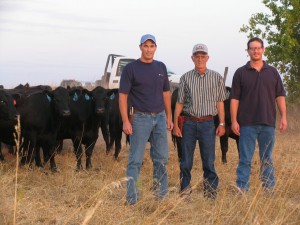
Here in the real world
I’ve also heard talk of how they baby their cattle and that they just “don’t get” what it’s like to be a commercial rancher.
I’ve spent time on registered ranches. Sometimes they have nicer fences or cleaner machine sheds, their places a little showier, but quite often I don’t think you’d be able to tell by looking if they were raising bulls or feeder steers. I’ve also heard many of them talk about their share of tough times and scraping by.
I draw from my boots-on-the-ground experience with today’s falsehood:
Myth: There aren’t any seedstock producers who know what it’s really like raising cattle in the real world.
Fact: Sure some producers are tunnel focused on the bull market, but a great many take great interest in all other segments of the beef business.

Take the Kansas Angus Association members. They recently wrapped up their Carcass Data Project where nine breeders co-mingled 79 calves to feed at McPherson Co. Feeders.
“This was kind of a learning experience,” said one consigner of his first shot at some firsthand feeding knowledge. “A good chance to compare with other good cattle,” said another.
Earlier this summer I was at Schiefelbein Farms in Minnesota, where they not only raise bulls, but also feed out calves.
“It also elevates your knowledge base,” says Don.
Between balancing rations and grid marketing they’re deeply entrenched in the same issues that a feedlot is. They know real-world and that helps direct their breeding program.

Still, a big handful of breeders are also in the commercial business. When I visited with Barb Downey at the Downey Ranch in Kansas a few years back, we mainly talked about her commercial herd.
“We started this commercial cow herd with the emphasis from the start on trying to produce higher-quality beef. We were already keeping the kind of records that you’d need, and we had established a real firm idea of what we wanted in our seedstock. We have a very grounded idea as to what’s important to a commercial man in our area, because that’s what we are.”
So many places I’ve been to, they talked about treating their cows just like any commercial cattle. They followed the same breeding season, no second chances for under-performers. Some might run a few more cows through a calving barn, but they’re still tied to making a profit. That’s a universal motivator. It’s good for their bottom line to see what makes yours.
As Danny Schiefelbein said, “Our whole goal is for them to be in the business a long time and the only way they can do that is to do it a profitable way.”
May your bottom line be filled with black ink,
Miranda
You may also like
Progress from small steps
Every day is a chance to learn and get better. Thousands of others like my new friends in Alabama are taking steps to meet the shifts in consumer demand, and to know more. Small steps in the right direction can start now. Even if it’s just recording a snapshot of where you are today, a benchmark for tomorrow.
Not perfect, but working to get better
The CAB Cattleman Connection team heard its name called more than once in the virtual ceremonies, and each time came a sense of personal accomplishment, but even better: confirmation that we’re getting better at our craft. I hope that means we’re doing a better job for you.
Beefed up findings
Frank Mitloehner presents his findings on the animal ag sector’s impact on global warming. He explains how cattle counterbalance other fossil fuel sectors, proving that cattle are a solution and not a threat.



